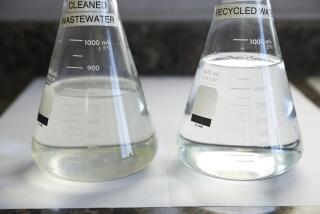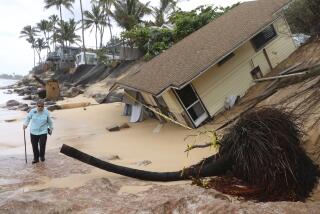Take Water Pollution Off Cruise Control
On any summer day in Alaska, a dozen massive cruise ships--some 14 stories high and three football fields long--ply our pristine waters to watch whales, witness glaciers calving and visit our coastal communities.
The 45,000 passengers and crew on those ships constitute a floating version of the third largest city in Alaska, smaller only than Anchorage and Fairbanks. That many people create a lot of waste.
Just one of those cruise ships can discharge 350,000 gallons every day of “gray water”--waste water from showers, sinks and kitchens--and treated sewage known as “black water.” And those discharges usually are in the constricted waters of Alaska’s Inside Passage, rarely more than six miles from shore. Last month, random samples of those discharges analyzed by Alaska and federal regulators produced shocking results. Of the 36 samples of sewage required by federal law to be treated, not one fully complied with federal standards.
Even more alarming, more than 70% of samples of gray water, which are not subject to federal standards, had levels of fecal coliform bacteria, an indication of human waste, that far exceeded the standards imposed on sewage. Three samples of what was supposed to be benign gray water contained fecal coliform levels measured at more than 50,000 times the federal standard for treated sewage.
Though Alaska is not unique in contending with the impacts of the cruise industry, our unique geography, our pristine environment and the dependence of Alaskans on the sea magnify our concerns. As the nation’s top seafood producer, Alaska’s oceans and watersheds are vital to the livelihood of thousands of Alaskans and other Americans.
That’s why it’s so troubling that the federal government, which has watched the cruise industry in Alaska grow more than 600% since 1982, has required virtually no treatment and monitoring of the wastes poured into Alaska’s and America’s coastal waters immediately outside the three-mile state jurisdiction.
Current federal law is riddled with loopholes, and enforcement is poor, while states are denied the authority to monitor and enforce compliance. The dirty secrets of cruise ships, most of which sail under flags of countries like Liberia and Panama for tax advantages, should not be allowed to hide behind international law.
The Coast Guard Reauthorization Act, which could give state and federal regulators the tools to prevent the continued fouling of Alaska’s and America’s waters, is pending before a House-Senate conference committee. Even that bill, however, fails to fully address the loopholes in existing law or allow for state monitoring and enforcement. But adequate amendments have been proposed.
Congress should act this year to set safe and protective discharge standards, prohibit the discharge of untreated sewage and regulate the discharge of treated sewage and gray water. Alaska and other states must have authority to create no-discharge zones in environmentally sensitive waters and to monitor, inspect and enforce standards.
Alaskans value the economic benefits of the 1 million tourists who visit our state each year, many of them on cruise ships. But our foremost responsibility is to maintain the health of our oceans. The cruise ship industry depends on marketing the natural beauty of the oceans on which it operates. Neither the industry nor America’s waters can thrive if those oceans are polluted.
More to Read
Sign up for Essential California
The most important California stories and recommendations in your inbox every morning.
You may occasionally receive promotional content from the Los Angeles Times.










